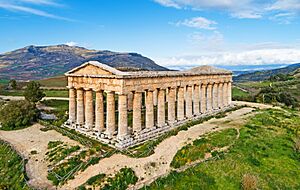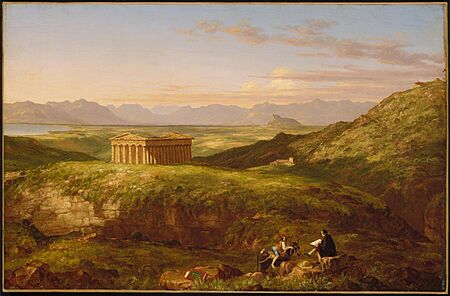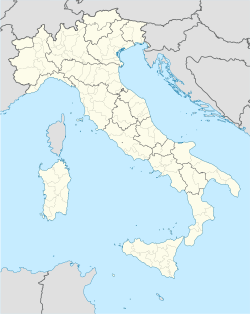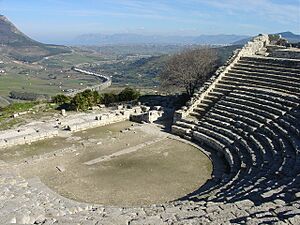Segesta facts for kids
|
Ἔγεστα
|
|

The Doric temple of Segesta
|
|
| Location | Calatafimi-Segesta, Province of Trapani, Sicily, Italy |
|---|---|
| Coordinates | 37°56′29″N 12°49′56″E / 37.94139°N 12.83222°E |
| Type | Settlement |
| History | |
| Cultures | Greek, Elymian |
| Site notes | |
| Condition | Preserved |
| Ownership | Public |
| Management | Soprintendenza BB.CC.AA. di Trapani |
| Public access | Yes |
| Website | Area Archeologica Segesta |
Segesta was an important ancient city in Sicily, Italy. It was one of the main cities of the Elymians, who were one of the three native groups living in Sicily. The other big Elymian cities were Eryx and Entella.
Segesta is located in the northwest part of Sicily, close to the modern town of Calatafimi-Segesta. Even though the Elymians were not Greek, their culture became very Greek-like over time.
Contents
History of Segesta
How Did Segesta Begin?
The exact start of Segesta is a bit of a mystery. One popular story, believed by the Greeks and later by the Romans, says that the city was founded by Trojan settlers. These were people who escaped after their city, Troy, was destroyed.
The Romans liked this story because it made them feel connected to Segesta. Another story says that the Elymians were already living there when the Trojans arrived.
There was also a tale that some people from Phocis (a region in ancient Greece) helped found Segesta. Later writers tried to combine these different stories.
A famous Roman poet, Virgil, wrote in his Aeneid that the city was founded by a local king named Egestus (also called Acestes). He was said to be the son of a Trojan woman and a river god. Some of Aeneas's people, who wanted to stay, also helped found the city.
The city was originally called Egesta or Acesta. Later, the Romans might have changed it to Segesta. They did this to avoid the Latin word egestās, which means "poverty" or "lack." However, old coins show that the name Segesta was used by the people themselves even before the Romans.
The people of Segesta were different from the native Sicanians of Sicily. They were not a Greek colony. Even so, they had strong connections with Greek cities. They often fought with or allied with Greek states, unlike other non-Greek groups on the island. Their early coins show Greek writing and art, proving how much Greek culture influenced them.
Segesta's Conflicts and Alliances
Segesta often had conflicts with its neighbors. Around 580 BC, they were fighting with Selinus (modern Selinunte). This suggests both cities had grown big enough to share a border. With help from some Greek settlers, Segesta won that fight.
Later, in 454 BC, Segesta was fighting over land near the Mazarus River. It's likely they were still fighting Selinus, as these two cities seemed to be in constant dispute.
To get stronger against Selinus, Segesta made a deal with Athens in 426 BC. This didn't help much at first. When fighting broke out again, Selinus got help from Syracuse. Segesta was in trouble, so they asked Athens for help again.
In 416 BC, Athens decided to send a large fleet to Sicily. It's said that Segesta tricked the Athenian messengers by showing off fake wealth. But Segesta did give Athens a lot of money to help their cause.
The Great Athenian Expedition
The main reason for the huge Athenian expedition to Sicily (415-413 BC) was to help Segesta. However, the Athenians ended up focusing on fighting Syracuse instead. Segesta played a small part in this war. They sent some troops to help Athens.
When Athens lost the war, Segesta was again open to attacks from Selinus. Segesta then asked the Carthaginians for help. Carthage sent troops, and Segesta won a victory over Selinus in 410 BC. The next year, a large Carthaginian army destroyed Selinus and Himera.
Carthage became very powerful in western Sicily. Segesta, surrounded by this power, became an ally of Carthage. Segesta stayed loyal to Carthage even when Dionysius I of Syracuse attacked in 397 BC. Dionysius tried to capture Segesta, but the city held out until a Carthaginian army arrived and forced Dionysius to leave.
Troubles and Roman Alliance
Segesta faced a terrible event under Agathocles of Syracuse. In 307 BC, Agathocles entered the city as a friend. But then he suddenly turned on the people, claiming they were disloyal. He killed about 10,000 citizens, stole their wealth, and sold the women and children into slavery. He even changed the city's name to Dicaeopolis.
Segesta probably never fully recovered from this. But it soon got its old name back and became independent again. In 276 BC, it joined Pyrrhus of Epirus when he came to Sicily.
Later, Segesta fell under Carthaginian control again. During the First Punic War (264 BC), Segesta was attacked by the Romans. The people of Segesta then killed the Carthaginian soldiers in their city and joined Rome. Because of this, and their supposed Trojan background, the Romans treated Segesta very well. They didn't have to pay taxes and were considered a free city.
After Carthage was destroyed, the Roman general Scipio Africanus returned a statue of Diana to Segesta. This statue had been taken by the Carthaginians.
Segesta was still an important town during the time of Cicero, a famous Roman speaker. It had its own port about 10 km away. The ancient city slowly declined and was finally abandoned around 900 AD, likely due to attacks by the Saracens. Today, the area is empty. The modern town of Castellammare del Golfo is near where Segesta's ancient port used to be.
Exploring the Ruins of Segesta
The ruins of Segesta are on top of Monte Bàrbaro, a hill 305 meters (about 1,000 feet) above sea level. The city was naturally protected by steep slopes on most sides. Walls protected the gentler slope leading to the temple.
From the hilltop, you can see the valley and the Gulf of Castellamare. The city was important because it controlled major roads connecting the coast to the inland areas. We don't know much about the city's exact layout. However, aerial photos suggest it had a planned design, built on terraces to fit the sloped land. The ruins we see today might be from the city's rebuilding after Agathocles destroyed it.
Recent digs show that a Muslim community lived here during the Norman period. Archaeologists found a Muslim cemetery and a mosque from the 12th century, next to a Norman castle. It seems the mosque was destroyed when Christian rulers took over in the early 13th century. The city appears to have been completely abandoned by the mid-1200s.
The Unfinished Temple of Segesta

Just outside the ancient city of Segesta, there's a very well-preserved Doric temple. It's quite unusual because Segesta wasn't a Greek city. Many believe the local Elymians built it around the 420s BC.
The temple has six columns on the front and back, and fourteen columns on its sides. It sits on a platform with three steps. The base measures about 21 by 56 meters (69 by 184 feet).
Several things suggest the temple was never finished. For example, the columns don't have the usual grooves (fluting) that Doric temples normally have. Also, there are still rough bumps (bosses) on the stone blocks of the base. These bumps were used to lift the blocks into place and were usually removed later.
The temple also doesn't have an inner room (cella), any decorations, an altar, or a dedication to a god. It was never roofed. It's thought that the war between Segesta and Selinunte stopped the construction. Luckily, it escaped being destroyed by the Carthaginians in the late 5th century BC.
Images for kids
-
Segesta Temple in Thomas Cole's painting from 1843






